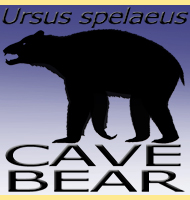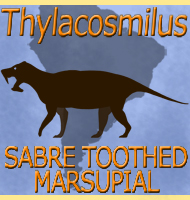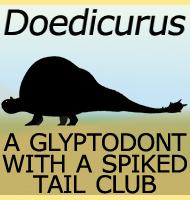


Agriotherium
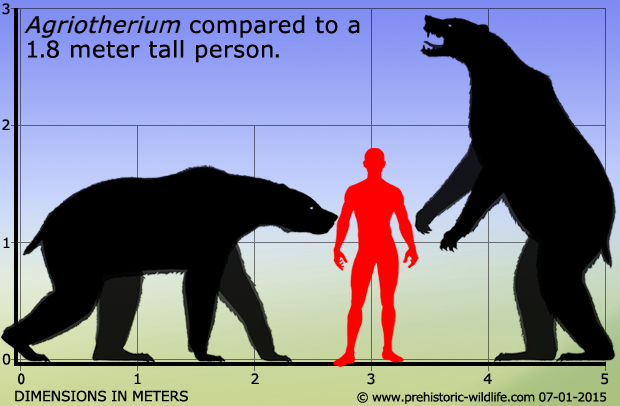
Name:
Agriotherium
(Sour beast).
Phonetic: Ag-ree-o-fee-ree-um.
Named By: Wagner - 1837.
Synonyms: Agriotherium coffeyi,
Hyaenarctos.
Classification: Chordata, Mammalia, Carnivora,
Arctoidea, Ursidae, Ursinae.
Species: T. sivalensis (type),
T. africanum, T. hendeyi, T. inexpetans, T. schneideri.
Diet: Probably an Omnivore.
Size: Approximately 2.7 meters long and up to
around 650 kilograms.
Known locations: Across Africa, Eurasia and North
America.
Time period: Serravalian of the Miocene through to
the Piacenzian of the Pliocene.
Fossil representation: Multiple individuals.
One
of the better known bears in the worlds fossil record, the
Agriotherium genus is also easily one of the largest
currently known.
With this large size it would be tempting to portray Agriotherium
as a
savage killers of any animal that might be unfortunate enough to be in
its way, yet like with its more famous relative Arctodus
(better
known as the giant short faced bear) first impressions may in this
case be deceptive. The post cranial skeleton of Agriotherium
is that
of a large but relatively underpowered animal that simply does not seem
to have the skeletal framework necessary to cope with high stresses,
such as those expected to be encountered while undergoing extreme
physical exertion (i.e. catching and subduing struggling prey).
The second clue is that Agriotherium has a
proportionately short snout
to that seen in many other bears. The advantages of having a short
snout are simple, it means that whatever is being bitten, is closer
to the point of jaw articulation (fulcrum) so that greater force
can be brought to bear (no pun intended) against it.
These
are all features that are common to Arctodus which
also has isotopic
analysis of its bones revealing that it was eating nearly every type of
animal in its ecosystem, something very unusual for a predator, but
common for a scavenger. Given the superficial similarity in form
between Agriotherium and Arctodus,
it’s reasonable to speculate that
Agriotherium may have been a specialised scavenger,
a theory that is
becoming increasingly put forward for Arctodus.
Again, the concept
is very simple, by being bigger than any other predator on the land,
Agriotherium could in effect bully the smaller
predators away from
their kills. This draws parallels in bear/wolf interaction that is
observed in the wild even today, where grizzly bears will watch a
pack of wolves bring down a prey animal, just to charge on in and
drive them off after they have done all of the work for it. This fits
with the surprisingly gracile skeleton of a large animal like
Agriotherium, since if it was letting other
predators do the work and
the killing for it, why waste precious nutrients and calories upon
developing and maintaining a skeleton stronger than it needed to be?
Another
thing to consider is that if Agriotherium was a
scavenger then it was
likely getting to carcasses after all of the choice pieces of meat had
been consumed with perhaps only bones being left. This would probably
not be enough to thwart Agriotherium from a meal
however since the
short snout, strong jaw closing muscles and robust construction of
the skull and jaws were all the things that Agriotherium
needed to
develop massive bite force. Computer modelling in a 2012 study
(see links below) confirmed that Agriotherium
had one of the largest
bite forces known amongst the members of the Carnivora (A group of
mammals that includes dogs, bears, cats, pinnipeds etc which are
specially adapted to exist by eating meat). By being able to crack
open bones, Agriotherium could access and eat the
bone marrow
within, and for those not familiar, bone marrow is one of the most
nutritious parts of an animal, and can last for several years after
an animals death when encased inside of the bones.
The
idea of Agriotherium being what is termed a
‘hyper-carnivore’ is
plausible, though it is not certain that Agriotherium
only ate meat.
Like with bears today, Agriotherium may have
also supplemented its
diet with fruits and certain plants, particularly tougher ones that
required strong jaws. However the scavenger theory does actually fit
better with Agriotherium in terms of the age of
known fossils.
Agriotherium first appears just after halfway
through the Miocene
before disappearing at the end of the Pliocene. The similar Arctodus
however begins to appear in the Pliocene before becoming most numerous
during the Pleistocene. It might be that Agriotherium
was one of the
first specialised scavenger bears but was eventually replaced in the
worlds ecosystems by more advanced versions that form separate
genera, as well as possibly other bone crunching animals such as
hyena.
Further reading
- Ecomorphology of the giant short-faced bears Agriotherium
and
Arctodus, B. Sorkin - 2006.
- Finite element analysis of ursid cranial mechanics and the prediction
of feeding behaviour in the extinct giant Agriotherium
africanum, C.
C. Oldfield, C. R. McHenry, P. D. Clausen, U.
Chamoli, W. C. H. Parr, D. D. Stynder, S. Wroe -
2012.
----------------------------------------------------------------------------
Random favourites
 |
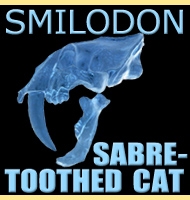 |
 |
